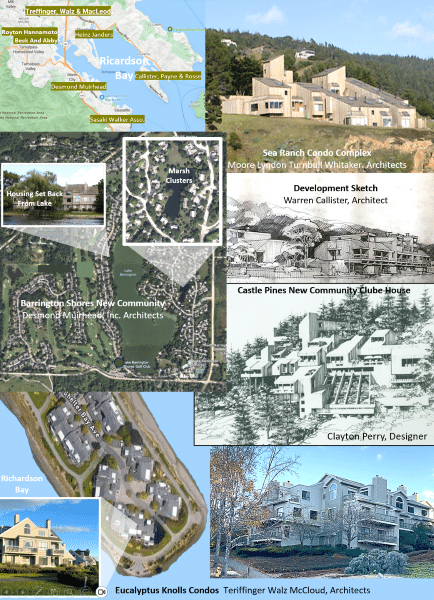California Architecture and scroll down through some 350 images and you will only see one example of a movement that started it all, the Charles Moore condo at Sea Ranch [1967]. Rooted in the rustic, bare timber, authentic Second Bay Architecture movement that spawned Maybeck, his Architecture firm, Moore Lyndon Turnbull Whitaker, integrated modern design with the natural world as never before. One thing to be out of the box and another to be awarded the highest National AIA Award. That turned the heads of the Bay Area design community, particularly shops in Southern Marin County. Here, between ’66 to ’76, they turned out hundreds of exquisite contemporary new multifamily residential community designs echoing the Moore Condo, bottomed on first time application of emerging environmental planning principles.
The intent here is to memorialize this crowd of exclusively Bay Area Urban Design shops that changed the look and feel of the built environment all over. Though MLTW, Lawrence Halprin, and Walz & Mcloud were in San Francisco, just 20 minutes away, since all the others shared a common Bay shoreline in Southern Marin, let’s call this movement the Richardson Bay Revolution. A driving force was the introduction of Planned Unit Development, primarily by the Urban Land Institute at the time, allowing subdivision design to break out of street grids into endless optimal planning possibilities. This story is told through descriptions of some of these architectural offices who gave birth to, perfected, and spread worldwide the California postmodern architecture you see today in residential design worldwide.

Moore Lyndon Turnbull Whitaker. This architectural firm was among the first to favor contextual designs—structures that fit well with the existing urban fabric. When hired to design an innovative, environmentally sensitive condominium complex at the Sea Ranch on the north coast, they applied some of their sensitivity to “place” to the project. This work by Charles Moore, chief architect, was hailed as a paradigm of ecologically sensitive design—and remains so today. Sticking close to the Sea Ranch development philosophy penned by the leading Landscape Architect of the day, Lawrence Halpern, MLTW were designers of numerous Sea Ranch residents where in the untouched natural world comes right down to the to the building edge with structures being only all natural materials, mostly unpainted wood. Instead of displacing the natural world, these structures were the vanguard of environmental compatibility, setting the style for responsive recycling the traditional board shed.
Callister, Payne & Rosse. Callister established the firm of Callister, Payne & Rosse in Tiburon, CA in 1950. John Payne and Martin Rosse worked with Callister designing residences, churches, and communities for which they received many awards. CPR were arguably the first to apply the environmentally complementary lessons learned at the Sea Ranch to residential community development in general. With gasoline at 32 cents/gallon, development of new towns and communities on cheap vacant land well beyond the urban fringe were all the rage through the early 70s. Such comprehensive residential developments offered a great opportunity to apply this new urbanism complete with a soft natural wood look and feel that has made the urban world more pleasant to look at near all over the world, particularly multifamily residential. Callister’s design focused on “Creating appropriate designs that belong to the natural environment and that are rooted in the nature of the clients.”
Desmond Muirhead, Inc. With its main office on a barge in Sausalito, starting in ’68, Gordon Desmond Muirhead, as a leading golf course architect, joined forces with Jack Nicolas to become essentially the father of the Golf Course Community. All included environmentally responsive condo clusters around golf course fairways. Desmond was famous for declaring that “DMI’s job is to develop expensive residential development on cheap land.” The lead Architect was Harry Ried. Though design delineators Terry Stevens and Serio O’Cadez often contributed, lead declinator Clayton Perry produced the over-the-top design studies like the Clubhouse at Village at Castle Pines [golf course community]. Dennis Klein, Sea Ranch’s Project Engineer, was hired away to be the firm’s lead Environmental and Community Planner. Here Klein produced some scores of environmental studies to identify suitable development patterns and often authored the community plans, some of which were developed just the way he drew them.
Of all the many new communities that DMI planned, Lake Barrington Shores, IL was perhaps the most ahead of its time. For starters, conventional housing in this NW Chicago suburb was half acre development. Other nearby natural lakes had half acre lots, big enough to assure septic tank use, that came right down to their shoreline. The developer had struck a deal with the county to go with a PUD such that by including a sewage treatment plant, overall density was increased to accommodate multifamily cluster development. Keeping in mind that this is 1972, Klein’s contributions were substantive in introducing new environmental concepts into the development process. For starters, he convinced all to hold development back upslope from the lake’s shoreline except for the marina. This not only created a highly attractive pedestrian path all the way around the lake but a great place to locate a collector sewer line to carry all waste to the treatment plant. Next, an impressive stand of trees was set aside as a forest preserve so that all residents would have access to an untouched wilderness experience. Along the same line, a marsh that could have been easily feasible to be filled in to create some additional 20 units was, instead, set aside, not as a constraint but as a feature. Keeping the area untouched, nearby residential units went for a premium price as Marsh Cluster Condos.
Teriffinger Walz McCloud. Somewhat saving the best for last, this one firm, though about five miles from Richardson Bay in San Rafael, CA is possibly responsible for more new community developments of this California Architectural style than any other firm at the time. A fine example of their work, highly representative of developments elsewhere, are the condo complexes and office parks built literally on the shores of Richardson Bay such as Eucalyptus Knolls, the development showcased here.
Published by: Holy Minoza






